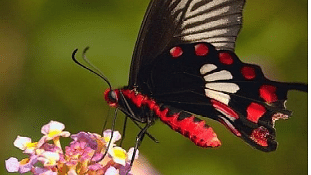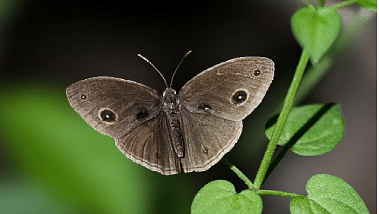- Fascinating Facts About the Sundarbans
- Manushi Chhillar at The Riverwood Forest Retreat, Dooars
- Holiday to the Land of Mowgli
- The Butterfly Lifecycle
- Interesting Facts About Pench Tiger Reserve: The Land of Iconic Tigers
- Butterfly Garden in Pench, Kanha and Dooars
- 7 Differences Between Butterflies and Moths
- Animal Facts
- Discovering the Avian Treasures of Sundarbans
- Safari Tips

Is a Moth a Butterfly? Understanding the Difference
Have you ever looked at a fluttering insect and wondered whether it was a butterfly or a moth? If so, you are not alone! This question has intrigued nature enthusiasts and casual observers alike. While both moths and butterflies belong to the order Lepidoptera, they exhibit many physical and behavioural differences.
Let us dive in to understand these distinctions and have some fun learning about these fascinating creatures!
Let us dive in to understand these distinctions and have some fun learning about these fascinating creatures!
Butterfly vs. Moth: Key Differences
| Feature | Butterflies | Moths |
| Activity | Active during the day (diurnal). | Mostly active at night and drawn to light (nocturnal). |
| Coloration | Bright and colourful wings. | Dull and less vibrant colours. |
| Body Structure | Smooth and slender. | Stockier with furry bodies. |
| Forelegs | Forelegs reduced or with missing segments. | Fully developed forelegs. |
| Pupation | Pupate in a chrysalis hanging under branches or leaves. | Spin cocoons for pupation or pupate underground. |
| Antennae | Slender with club-like or knobbed ends. | Feathery or sharply pointed antennae. |
| Wing Position at Rest | Wings held upright and together. | Wings spread open when resting. |

Lifecycle of a Butterfly: Nature’s Marvel
Butterflies undergo one of the most captivating metamorphoses in the insect world. Here is a breakdown of their four life stages:
- Egg: The journey begins when a female lays tiny eggs on host plants.
- Larva (Caterpillar): The egg hatches into a hungry caterpillar, which focuses on eating and growing.
- Pupa (Chrysalis): The caterpillar forms a protective chrysalis and undergoes transformation.
- Adult: A stunning butterfly emerges, ready to feed on nectar and reproduce.
Moths have a similar lifecycle but differ in how they pupate—usually spinning cocoons or even burrowing underground for protection.
Behavioural Insights
Butterflies are day lovers. Their diurnal nature means they are often seen basking in the sunlight, hopping from flower to flower to sip nectar. Moths, on the other hand, are the nightlife enthusiasts of the Lepidoptera world. Their nocturnal nature explains why they are often found hovering around porch lights in the evening.
Physical Distinctions
One of the easiest ways to tell butterflies and moths apart is their antennae. Butterflies have elegant, thin antennae with clubbed ends, while moths boast feathery or pointed antennae. Their bodies also differ butterflies are sleek, whereas moths appear robust and furry.
Their wings tell another story. Butterflies rest with their wings closed vertically above their bodies, like they are preparing for flight. Moths, however, rest with wings spread open, often blending into their surroundings.
Pupation Processes: Chrysalis vs. Cocoon
One of the most fascinating differences lies in how these insects transition into adulthood. Butterflies create a chrysalis, which is a smooth, hard shell that dangles from branches or leaves. Moths, on the other hand, spin protective cocoons around themselves, or sometimes pupate underground.
Why Are Moths Duller in Colour?
The muted hues of moths are a defence mechanism. Being nocturnal, moths rely on camouflage to blend into their environment and avoid predators. Butterflies, with their bright colours, use their appearance to either attract mates or warn predators of their potential toxicity.
Fun Fact for Kids
Did you know that butterflies and moths also differ in their contribution to nature? Butterflies are excellent pollinators, while moths play a dual role in pollination and as a food source for various nocturnal animals like bats.
Fun Fact: The Largest Moth
The Atlas moth, native to tropical Asia, is the largest moth in the world. Its wingspan can exceed 6 inches, making it a true giant of the Lepidoptera family!
See Butterflies and Moths Up Close
For those eager to witness the beauty of butterflies and moths firsthand, consider visiting The Riverwood Forest Retreat in Pench or Dooars. These luxurious retreats offer a unique opportunity to explore butterfly parks and gardens, perfect for families and nature enthusiasts alike.
- The Riverwood Forest Retreat, Pench: Enjoy an immersive wildlife experience with activities for both adults and kids.
- The Riverwood Forest Retreat, Dooars: Discover the magic of Dooars with lush gardens and family-friendly activities.
Why Visit a Butterfly Garden?
Spending time in a butterfly garden is not just educational—it is also therapeutic. Watch butterflies flit among colourful flowers, marvel at their intricate patterns, and learn about their vital role in pollination.
Stay Tuned for More!
If you are fascinated by butterflies and moths, do not miss our upcoming blogs where we explore the butterflies of Pench and the butterflies of Dooars. Discover their vibrant diversity and learn why these regions are a paradise for butterfly enthusiasts!
Frequently Asked Questions
- Are all moths nocturnal?
No, not all moths are nocturnal. While most moths are active at night, some species, like the hummingbird moth, are diurnal. - Do moths pollinate plants?
Yes! Moths play a significant role in pollination, especially for plants that bloom at night. - Can butterflies be dull in colour?
Yes, not all butterflies are bright. Some, like the cabbage white butterfly, have subtle colours for camouflage. - Are moths attracted to all lights?
Moths are especially attracted to ultraviolet and blue light, which disrupt their natural navigation systems. - What is the lifespan of a butterfly compared to a moth?
Butterflies live for a few weeks, while moth lifespans vary widely depending on the species, with some living only a few days and others for several months. - How do you attract butterflies to your garden?
Plant nectar-rich flowers, avoid pesticides, and provide sunny spots for butterflies to bask.
Learn More in Upcoming Blogs
Stay tuned as we dive into the world of Butterflies of Pench and Butterflies of Dooars in our upcoming blogs. There is so much more to discover about these delicate yet resilient creatures!
Subscribe and Share
If you enjoyed this blog, do not keep it to yourself!